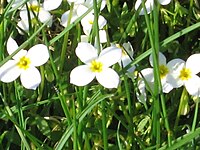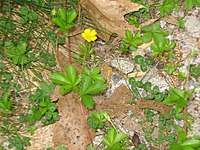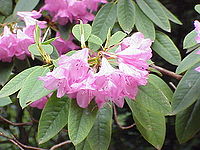Bloom Clock/Keys/New Hampshire/June/All
Rosa

This page is part of a dichotomous key for plants recorded as blooming in New Hampshire during the month of June.
 Wikipedia • Commons • Wikibooks (horticulture) • Wikibooks (subject) • Wikispecies • Fruit and seed clock |
Profile for Rosa (Rose)
Recent Logsedit
| ||||||||||||||
Global data:
Temperate zone season(s): Late Spring, Early Summer, Mid Summer, Late Summer, Early Fall Mid Fall, Late Fall
Rumex crispus
 Wikipedia • Commons • Wikibooks (horticulture) • Wikibooks (subject) • Wikispecies • Fruit and seed clock |
Profile for Rumex crispus (Curly Dock)
Recent Logsedit
| ||
Global data:
Temperate zone season(s): Early Summer, Mid Summer, Late Summer, Early Fall
Chenopodium album
 Wikipedia • Commons • Wikibooks (horticulture) • Wikibooks (subject) • Wikispecies • Fruit and seed clock |
Profile for Chenopodium album (Lambsquarters, Goosefoot)
Recent Logsedit
| ||||||||
Global data:
Temperate zone season(s): Mid Summer, Late Summer, Early Fall, Mid Fall, Late Fall
Silene latifolia
 Wikipedia • Commons • Wikibooks (horticulture) • Wikibooks (subject) • Wikispecies • Fruit and seed clock |
Profile for Silene latifolia (White Campion)
Recent Logsedit
| ||
Global data:
Temperate zone season(s): Late Spring, Early Summer, Mid Summer
Solanum dulcamara
 Wikipedia • Commons • Wikibooks (horticulture) • Wikibooks (subject) • Wikispecies • Fruit and seed clock |
Profile for Solanum dulcamara (Bittersweet, Bitter Nightshade, Blue Bindweed, Climbing Nightshade)
Recent Logsedit
| ||||||||||||
Global data:
Temperate zone season(s): Early Summer, Mid Summer, Late Summer, Early Fall, Mid Fall
Centaurea montana
 Wikipedia • Commons • Wikibooks (horticulture) • Wikibooks (subject) • Wikispecies • Fruit and seed clock |
Profile for Centaurea montana (Perennial Cornflower)
Recent Logsedit
| ||
Global data:
Temperate zone season(s): Late Spring, Early Summer, Mid Summer
Fragaria vesca
 Wikipedia • Commons • Wikibooks (horticulture) • Wikibooks (subject) • Wikispecies • Fruit and seed clock |
Profile for Fragaria vesca (Woodland Strawberry)
Recent Logsedit
| ||
Global data:
Temperate zone season(s): Mid Spring, Late Spring, Late Summer, Early Fall
Plantago major
 Wikipedia • Commons • Wikibooks (horticulture) • Wikibooks (subject) • Wikispecies • Fruit and seed clock |
Profile for Plantago major (Broadleaf Plantain)
Recent Logsedit
| ||||||||||
Global data:
Temperate zone season(s): Early Summer, Mid Summer, Late Summer
Kalmia angustifolia
 Wikipedia • Commons • Wikibooks (horticulture) • Wikibooks (subject) • Wikispecies • Fruit and seed clock |
Profile for Kalmia angustifolia (Sheep-laurel)
Recent Logsedit
| ||||||||
Global data:
Temperate zone season(s): Early Summer, Mid Summer
Frangula alnus
 Wikipedia • Commons • Wikibooks (horticulture) • Wikibooks (subject) • Wikispecies • Fruit and seed clock |
Profile for Frangula alnus (Glossy Buckthorn)
Recent Logsedit | ||||||||||||
Global data:
Temperate zone season(s): Early Summer, Mid Summer
Houstonia caerulea
 Wikipedia • Commons • Wikibooks (horticulture) • Wikibooks (subject) • Wikispecies • Fruit and seed clock |
Profile for Houstonia caerulea (Azure Bluet)
Recent Logsedit
| ||||||||||||||||
Global data:
Temperate zone season(s): Mid Spring, Late Spring, Early Summer, Mid Summer
Cornus canadensis
 Wikipedia • Commons • Wikibooks (horticulture) • Wikibooks (subject) • Wikispecies • Fruit and seed clock |
Profile for Cornus canadensis (Common bunchberry)
Recent Logsedit
| ||||||||||||||
Global data:
Vicia cracca
 Wikipedia • Commons • Wikibooks (horticulture) • Wikibooks (subject) • Wikispecies • Fruit and seed clock |
Profile for Vicia cracca (Tufted Vetch)
Recent Logsedit
| ||
Global data:
Temperate zone season(s): Late Spring, Early Summer, Mid Summer, Late Summer, Early Fall, Mid Fall, Late Fall
Lotus corniculatus
 Wikipedia • Commons • Wikibooks (horticulture) • Wikibooks (subject) • Wikispecies • Fruit and seed clock |
Profile for Lotus corniculatus (Birdsfoot Trefoil)
Recent Logsedit
| ||||||||||||||
Global data:
Temperate zone season(s): Late Spring, Early Summer, Mid Summer, Late Summer, Early Fall, Mid Fall
Elaeagnus umbellata
 Wikipedia • Commons • Wikibooks (horticulture) • Wikibooks (subject) • Wikispecies • Fruit and seed clock |
Profile for Elaeagnus umbellata (Autumn Olive)
Recent Logsedit
| ||||||||||||||||||||
Global data:
Achillea millefolium
 Wikipedia • Commons • Wikibooks (horticulture) • Wikibooks (subject) • Wikispecies • Fruit and seed clock |
Profile for Achillea millefolium (Common Yarrow)
Recent Logsedit
TristanDolciano *˜˜˜12:00, 22 July 2019 (UTC) | ||||||||||
Global data:
Temperate zone season(s): Late Spring, Early Summer, Mid Summer, Late Summer, Early Fall, Mid Fall, Late Fall
Maianthemum canadense
 Wikipedia • Commons • Wikibooks (horticulture) • Wikibooks (subject) • Wikispecies • Fruit and seed clock |
Profile for Maianthemum canadense (False Lily-of-the-valley)
Recent Logsedit
| ||||||||||
Global data:
Aquilegia canadensis
 Wikipedia • Commons • Wikibooks (horticulture) • Wikibooks (subject) • Wikispecies • Fruit and seed clock |
Profile for Aquilegia canadensis (Columbine)
Recent Logsedit
| ||||||||||||
Global data:
Hieracium pratense
 Wikipedia • Commons • Wikibooks (horticulture) • Wikibooks (subject) • Wikispecies • Fruit and seed clock |
Profile for Hieracium pratense (Yellow Hawkweed, King Devil)
Recent Logsedit
| ||||||||||||||||
Global data:
Temperate zone season(s): Late Spring, Early Summer, Mid Summer, Late Summer
Rubus pensilvanicus
 Wikipedia • Commons • Wikibooks (horticulture) • Wikibooks (subject) • Wikispecies • Fruit and seed clock |
Profile for Rubus pensilvanicus (Blackberry)
Recent Logsedit
| ||
Global data:
Temperate zone season(s): Late Spring, Early Summer
Maianthemum racemosum
 Wikipedia • Commons • Wikibooks (horticulture) • Wikibooks (subject) • Wikispecies • Fruit and seed clock |
Profile for Maianthemum racemosum (False Solomon's Seal)
Recent Logsedit
| ||
Global data:
Temperate zone season(s): Late Spring, Early Summer
Potentilla canadensis
 Wikipedia • Commons • Wikibooks (horticulture) • Wikibooks (subject) • Wikispecies • Fruit and seed clock |
Profile for Potentilla canadensis (Dwarf Cinquefoil)
Recent Logsedit | ||||||||||||
Global data:
Aralia nudicaulis
 Wikipedia • Commons • Wikibooks (horticulture) • Wikibooks (subject) • Wikispecies • Fruit and seed clock |
Profile for Aralia nudicaulis (Wild Sarsaparilla, Smooth Sarsaparilla)
Recent Logsedit
| ||||||||||||||||
Global data:
Oxalis stricta
 Wikipedia • Commons • Wikibooks (horticulture) • Wikibooks (subject) • Wikispecies • Fruit and seed clock |
Profile for Oxalis stricta (Common Yellow Woodsorrel)
Recent Logsedit
| ||||||||||||||
Global data:
Temperate zone season(s): Mid Spring, Late Spring, Early Summer, Mid Summer, Late Summer, Early Fall, Mid Fall, Late Fall
Veronica officinalis
 Wikipedia • Commons • Wikibooks (horticulture) • Wikibooks (subject) • Wikispecies • Fruit and seed clock |
Profile for Veronica officinalis (Heath Speedwell)
Recent Logsedit | ||||||||||||
Global data:
Cypripedium acaule
 Wikipedia • Commons • Wikibooks (horticulture) • Wikibooks (subject) • Wikispecies • Fruit and seed clock |
Profile for Cypripedium acaule (Pink Lady's Slipper, Moccasin Flower)
Recent Logsedit
| ||||||||||||||
Global data:
Trifolium repens
 Wikipedia • Commons • Wikibooks (horticulture) • Wikibooks (subject) • Wikispecies • Fruit and seed clock |
Profile for Trifolium repens (White Clover)
Recent Logsedit
| ||||||||||
Global data:
Temperate zone season(s): Late Spring, Early Summer, Mid Summer, Late Summer, Early Fall, Mid Fall
Trifolium pratense
 Wikipedia • Commons • Wikibooks (horticulture) • Wikibooks (subject) • Wikispecies • Fruit and seed clock |
Profile for Trifolium pratense (Red Clover)
Recent Logsedit
| ||||||||||
Global data:
Temperate zone season(s): Late Spring, Early Summer, Mid Summer, Late Summer, Early Fall, Mid Fall, Late Fall
Sisyrinchium montanum
 Wikipedia • Commons • Wikibooks (horticulture) • Wikibooks (subject) • Wikispecies • Fruit and seed clock |
Profile for Sisyrinchium montanum (Blue-eyed Grass)
2009 Logsedit
Recent Logsedit
| ||
Global data:
Temperate zone season(s): Late Spring, Early Summer
Rumex acetosella
 Wikipedia • Commons • Wikibooks (horticulture) • Wikibooks (subject) • Wikispecies • Fruit and seed clock |
Profile for Rumex acetosella (Sheepsorrel)
Recent Logsedit
| ||||||||||||
Global data:
Temperate zone season(s): Late Spring, Early Summer
Robinia pseudoacacia
 Wikipedia • Commons • Wikibooks (horticulture) • Wikibooks (subject) • Wikispecies • Fruit and seed clock |
Profile for Robinia pseudoacacia (Black Locust)
Recent Logsedit
| ||
Global data:
Temperate zone season(s): Late Spring
Cerastium
 Wikipedia • Commons • Wikibooks (horticulture) • Wikibooks (subject) • Wikispecies • Fruit and seed clock |
Profile for Cerastium (Mouse-ear Chickweed)
Recent Logsedit | ||
Global data:
Temperate zone season(s): Late Spring, Early Summer
Vaccinium
 Wikipedia • Commons • Wikibooks (horticulture) • Wikibooks (subject) • Wikispecies • Fruit and seed clock |
Profile for Vaccinium (Blueberry, Cranberry)
Recent Logsedit
| ||
Global data:
Temperate zone season(s): Mid Spring, Late Spring
Viola tricolor
 Wikipedia • Commons • Wikibooks (horticulture) • Wikibooks (subject) • Wikispecies • Fruit and seed clock |
Profile for Viola tricolor (Heartsease, Johnny-jump-up)
Recent Logsedit
| ||
Global data:
Temperate zone season(s): Early Summer, Mid Summer, Late Summer, Early Fall, Mid Fall
Rhododendron
 Wikipedia • Commons • Wikibooks (horticulture) • Wikibooks (subject) • Wikispecies • Fruit and seed clock |
Profile for Rhododendron (Rhododendrons and Azaleas)
Recent Logsedit | ||||
Global data:
Temperate zone season(s): Early Spring, Mid Spring, Late Spring, Early Summer, Mid Summer
Syringa vulgaris
 Wikipedia • Commons • Wikibooks (horticulture) • Wikibooks (subject) • Wikispecies • Fruit and seed clock |
Profile for Syringa vulgaris (Common Lilac)
Recent Logsedit
| ||
Global data:
Temperate zone season(s): Mid Spring, Late Spring
Ranunculus
 Wikipedia • Commons • Wikibooks (horticulture) • Wikibooks (subject) • Wikispecies • Fruit and seed clock |
Profile for Ranunculus (Buttercup)
Recent Logsedit
| ||||
Global data:
Temperate zone season(s): Early Spring, Mid Spring
Clintonia borealis
 Wikipedia • Commons • Wikibooks (horticulture) • Wikibooks (subject) • Wikispecies • Fruit and seed clock |
Profile for Clintonia borealis (Clintonia, Corn Lily)
Recent Logsedit
| ||||||||||||
Global data:
Convallaria majalis
 Wikipedia • Commons • Wikibooks (horticulture) • Wikibooks (subject) • Wikispecies • Fruit and seed clock |
Profile for Convallaria majalis (Lily of the Valley)
Recent Logsedit
| ||||||||||||||||
Global data:
Viola
 Wikipedia • Commons • Wikibooks (horticulture) • Wikibooks (subject) • Wikispecies • Fruit and seed clock |
Profile for Viola (Violet)
Recent Logsedit
| ||||
Global data:
Temperate zone season(s): Mid Spring, Late Spring, Early Summer, Mid Summer, Early Fall, Mid Fall, Late Fall, Early Winter
Medeola virginiana
 Wikipedia • Commons • Wikibooks (horticulture) • Wikibooks (subject) • Wikispecies • Fruit and seed clock |
Profile for Medeola virginiana (Indian cucumber-root)
Recent Logsedit
| ||||||||||||||||
Global data:
Temperate zone season(s): Early Summer, Mid Summer
Orobanche uniflora
 Wikipedia • Commons • Wikibooks (horticulture) • Wikibooks (subject) • Wikispecies • Fruit and seed clock |
Profile for Orobanche uniflora (One-flowered Cancerroot)
Recent Logsedit
| ||||||||||||
Global data:
Comptonia peregrina
 Wikipedia • Commons • Wikibooks (horticulture) • Wikibooks (subject) • Wikispecies • Fruit and seed clock |
Profile for Comptonia peregrina (Sweetfern)
Recent Logsedit
| ||||||||||||||||
Global data:
Amelanchier bartramiana
 Wikipedia • Commons • Wikibooks (horticulture) • Wikibooks (subject) • Wikispecies • Fruit and seed clock |
Profile for Amelanchier bartramiana (Mountain Juneberry, Oblongfruit Serviceberry)
Recent Logsedit
| ||||||||||||||||
Global data:
Polygala paucifolia
 Wikipedia • Commons • Wikibooks (horticulture) • Wikibooks (subject) • Wikispecies • Fruit and seed clock |
Profile for Polygala paucifolia (Gaywings)
Recent Logsedit
| ||||||||||||
Global data:
Trientalis borealis
 Wikipedia • Commons • Wikibooks (horticulture) • Wikibooks (subject) • Wikispecies • Fruit and seed clock |
Profile for Trientalis borealis (Starflower)
Recent Logsedit
| ||||||||||||
Global data:
Spergularia
 Wikipedia • Commons • Wikibooks (horticulture) • Wikibooks (subject) • Wikispecies • Fruit and seed clock |
Profile for Spergularia (Sandspurry)
Recent Logsedit
| ||||||||||||||
Global data:
Temperate zone season(s): Late Spring, Early Summer, Mid Summer, Late Summer, Early Fall
Aesculus hippocastanum
 Wikipedia • Commons • Wikibooks (horticulture) • Wikibooks (subject) • Wikispecies • Fruit and seed clock |
Profile for Aesculus hippocastanum (Horse Chestnut)
Recent Logsedit
| ||
Global data:
